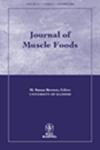CHANGES IN QUALITY OF MINCED MEAT FROM GOAT DUE TO GAMMA IRRADIATION
Abstract
ABSTRACT
Thigh muscles from aged (3–4 years) goat were minced, packed in polyethylene bags (250 g each), gamma irradiated with a dosage of 4 kGy and the packets held at 3 ± 1C for 8 days. Nonirradiated muscle mince packed and stored similarly were treated as control. Both irradiated and nonirradiated muscle mince were sampled on 0, 5 and 8 days of storage and analyzed for physicochemical, microbiological and sensory quality attributes. Irradiation resulted in lower (P ≤ 0.05) muscle pH (3.5–5.1%), water holding capacity (4.5–6.7%), thiobarbituric acid values (19.4–34.9%) and higher (P ≤ 0.05) free fatty acid (26.9–61.0%) and Hunter a* (3.3–17.3%) values compared with nonirradiated control muscle samples. A reduction (P ≤ 0.05) of 2 log cfu/g in total aerobic bacteria and psychrotrophs, and 1 log cfu/g in total staphylococci, yeast and molds were also observed in irradiated samples while enterococci, Escherichia coli and Staphylococcus aureus could not be detected in irradiated and stored muscles. Sensory quality scores on a 9-point hedonic scale decreased from 7.5–8.3 to 7.1–7.9 during storage at 3 ± 1C for 8 days and were marginally influenced by irradiation. The results establish that a 4-kGy dosage is appropriate for irradiation to maintain fresh meat quality under chilled condition.
PRACTICAL APPLICATIONS
Muscles are highly perishable primarily because high microbial load and irradiation effectively reduces the microbial counts and helps extension of shelf life of muscle foods. Production and retention of free radicals produced by irradiation cause changes in, apart from bacterial counts, proteins and lipids which in turn may affect functional properties such as water holding capacity and emulsion and sensory characteristics. Many muscle foods, such as sausages, burgers, loaves, kebabs, etc., are emulsion-type products, a quality that is dependent on functional properties of muscles' proteins/lipids. These products are industrially produced and are marketed in India and abroad. The industry is aware of the beneficial effect of irradiation in reducing the microbial load but has an apprehension that irradiation may adversely affect the functional properties and sensory characteristics of muscle foods. The study reported in this paper overcomes that apprehension when meat was irradiated with a permitted dosage of 4 kGy.

 求助内容:
求助内容: 应助结果提醒方式:
应助结果提醒方式:


